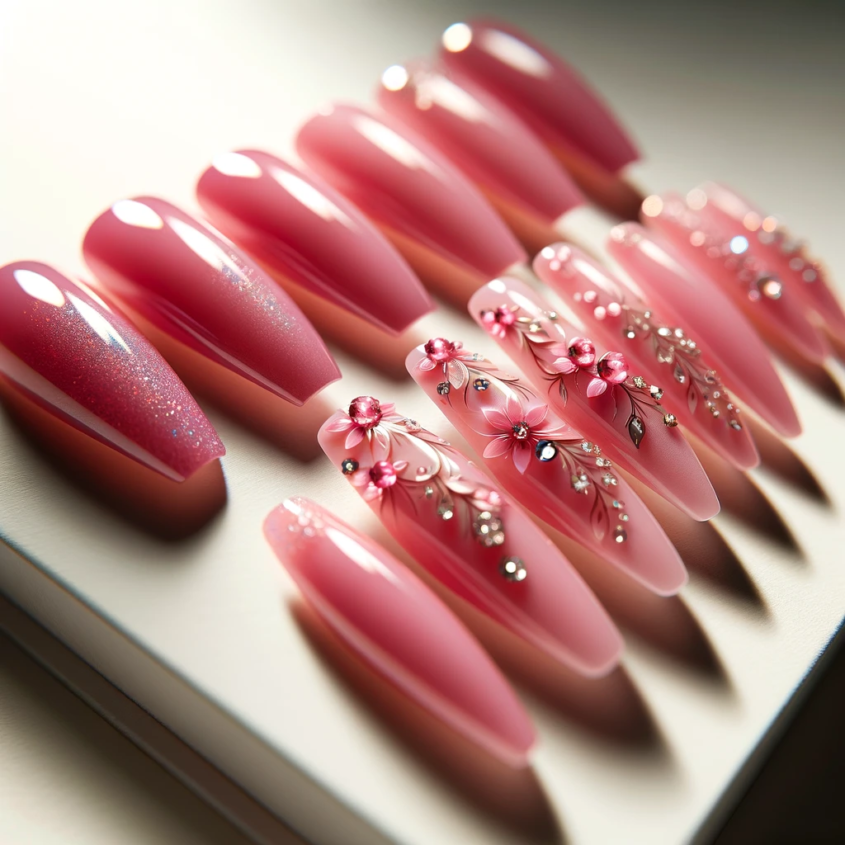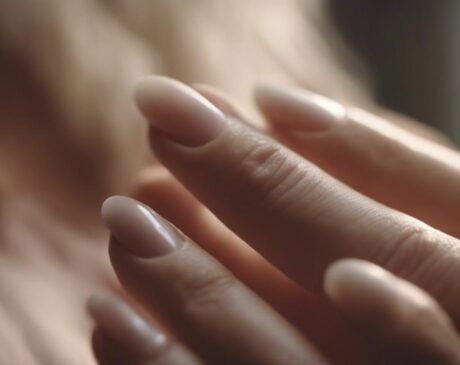What is the strongest glue for stick on nails?

Nail stickers are an innovation in the beauty industry that has revolutionized the way we think about nail art. They offer a quick, convenient and often more affordable alternative to traditional salon acrylics. With advances in design and quality, these nails have become the go-to choice for those seeking a professional manicure without the time or expense of a trip to the salon.
The Evolution of Self-Adhesive Nails
The journey of self-adhesive nails from simple pre-molded tips to today’s sophisticated versions reflects the evolution of beauty and fashion trends. Initially, these nails were basic and limited in style. However, with the advent of new materials and technology, stick-on nails have evolved. Modern versions offer a wide range of styles, from natural finishes to intricate designs that cater to different aesthetic preferences. This evolution has not only made them more attractive, but has also improved their wearability and comfort.
The importance of choosing the right glue
The key to maximizing the potential of glued nails is the adhesive used. The right glue ensures that the nails are held firmly in place, maintaining their appearance and integrity. Poor quality glues can cause nails to fall off prematurely or, worse, damage the natural nail underneath. Choosing the right glue is critical to the longevity of the affixed nails and the health of your natural nails.
Types of Nail Glue
The market offers various types of glue, each with unique properties suited to different needs and preferences. Understanding these types helps to make an informed choice.
Cyanoacrylate Glue
Cyanoacrylate is a key ingredient in many nail glues and is known for its fast bonding properties. This type of glue is perfect for those looking for a fast, long-lasting bond. It is especially favored for its strength and ability to withstand daily wear and tear. However, it is important to apply it carefully as it can bond quickly and firmly.
Resin glue
Resin glue is another popular option. They typically offer a more flexible bond compared to cyanoacrylate glues, which makes them ideal for those who like the flexibility of sticking their nails. This type of glue is often recommended for those with more active lifestyles, as it can better absorb impact and reduce the risk of nail peeling.
Natural Adhesives
Natural adhesives can be used for those with sensitive skin or those looking for a more natural alternative. They are usually made from less irritating chemicals and are gentler on the skin and nails. While they may not provide the same strength as synthetic products, they are a viable option for people with allergies or sensitivities.
Factors that Determine the Strength of Glue
The effectiveness of nail glue depends on more than just its chemical composition. Several other factors play a crucial role in its performance.
Adhesive Composition
The chemical composition of the glue determines its bond strength, flexibility and durability. Understanding its composition helps in choosing the glue that best suits one’s lifestyle and nail type.
Nail Preparation Techniques
Proper nail preparation is essential for adhesives to work effectively. This includes cleaning natural nails to ensure they are free of grease or debris and sometimes lightly buffing the surface for better adhesion. Neglecting these steps may result in weakened adhesion and shorten the life of your self-adhesive nails.
Environmental factors
External factors such as humidity, temperature and exposure to water or chemicals can also affect the performance of nail adhesive. For example, high humidity or frequent exposure to water can weaken adhesion. Choosing a glue that adapts to these environmental factors is important to maintain a long-lasting manicure.
DIY Nail Glue Alternatives
Not everyone is a fan of commercial adhesives in the realm of pasting nails. DIY nail glue alternatives are becoming increasingly popular for a variety of reasons, from skin sensitivities to a preference for natural solutions. These homemade solutions can be very effective and are often made from readily available household items.
Homemade Recipes
A popular homemade nail glue recipe is a simple mixture of clear nail polish and PVA glue. To do this, mix equal parts of PVA glue and clear nail polish in a small container. This mixture provides good holding power and is easy to remove, making it a great temporary solution. Another method involves mixing double-sided adhesive tape with clear nail polish to create a temporary adhesive layer that can be applied directly to the nail.
Safety and Effectiveness
While homemade glue can be a creative and economical solution, caution must be exercised. The bonding strength of these glues is usually lower than that of commercial products and is suitable for short-term use. It is also vital to ensure that you are not allergic to any of the ingredients used in these homemade recipes.
Application Techniques for Maximum Adhesion
In order to get the best results in attaching your nails, proper application techniques are crucial, whether you are using commercial or homemade glues.
Surface Preparation
The key to a strong bond starts with a clean, dry and lightly polished nail surface. Clean your nails with an alcohol pad to remove any natural oils or residue. If your nails are shiny, gently polish your nails to give them a slightly rougher surface. This roughness helps create more surface area for the glue to adhere to.
Proper application
Apply a thin layer of glue to the back of your stick-on or natural nail. Firmly press the stick-on nail onto the natural nail, starting at the cuticle and pressing toward the tip to avoid air bubbles. Hold it in place for a few seconds to ensure a strong bond.
Common mistakes to avoid
Certain common mistakes can compromise the integrity and appearance of your nail stickers.
Applying too much glue
Using too much glue can cause it to ooze out from underneath the nail, creating a messy appearance and potentially damaging the natural nail. It also makes removal more challenging. A thin, even layer of glue is enough to hold it firmly in place.
Neglecting Nail Health
Regular use of nail stickers without proper care can lead to weakened natural nails. Make sure you give your nails a break between applications and nourish them with cuticle oil and nail strengthener.
Removal and Aftercare
Proper removal and aftercare is essential to maintaining healthy nails.
Safe Removal Practices
Never force or pull on nail stickers as this can damage your natural nails. Soak your nails in warm soapy water to loosen the glue. You can also use commercially available nail adhesive remover or gently lift the edges of the glued nail after soaking.
Caring for your nails after removal
Care for your natural nails after removing sticky nails. Moisturize them with a nourishing cuticle oil and consider using a nail strengthener if they feel weak or brittle. Regular manicures, even if it’s just a protective clear coat, will help keep your nails healthy.
Expert advice and recommendations
When it comes to the longevity and safety of nail stickers, expert opinion and advice can provide valuable guidance. Professionals in the nail care industry often gain insights from years of experience and observations of industry trends and product performance.
Advice from Nail Technicians
Nail technicians often recommend using high-quality, commercial-grade nail adhesives for best results. They emphasize the importance of choosing a glue that is specifically formulated for applying nails to prevent damage to natural nails. Experts also advise against using strong glues or other household adhesives as they can be harsh and damage both artificial and natural nails.
User reviews and testimonials
User reviews and testimonials can provide real insights into the performance of different nail glues. Many users have shared their experiences with the longevity of the adhesive, the ease of use, and the overall health of their natural nails after application. These reviews can be a valuable resource for understanding how a product performs outside of a controlled testing environment and can highlight any potential issues or benefits.
Our exploration of the strongest adhesive nail glues reveals several key points. First, the choice of glue is critical to the longevity of the adhered nails and the health of the natural nail. Second, proper application and removal techniques are critical to maximize bonding and minimize damage. Finally, while DIY alternatives may be tempting, they often lack the staying power and safety of commercial products.
For best results, choose a high-quality commercial nail adhesive and follow the manufacturer’s application and removal instructions. Prioritize products that have received positive reviews and endorsements from nail care professionals. Remember to care for your natural nails regularly to maintain their health and strength.
Frequently Asked Questions
What makes nail glue strong and durable?
The strength and durability of nail glue depend on its chemical composition, which is usually a cyanoacrylate or resin-based formula. These components are specifically designed for optimal adhesion and abrasion resistance.
How often should I replace my adhesive nails?
Adhesive nails should usually be replaced every 1-2 weeks, depending on the growth of the natural nail and the durability of the adhesive. Regular replacement also helps maintain nail hygiene and health.
Is homemade nail glue as effective as store-bought nail glue?
Homemade nail glues are usually not as effective as store-bought nail glues. They may not provide the same level of adhesion and durability and are therefore more suitable for temporary use.
Will strong nail polish damage my natural nails?
Strong nail polish can damage natural nails if not used properly. Always follow application and removal instructions carefully and allow your nails to rest between applications.
What is the best way to remove sticky nails without damaging my natural nails?
The safest way to remove sticky nails is to soak them in warm soapy water or a special nail glue remover. This will soften the glue so that the nail can be gently removed without having to pull or force the nail off.




